
Ahmed II was the sultan of the Ottoman Empire from 1691 to 1695.
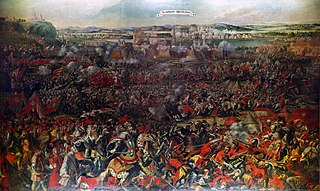
The Battle of Vienna took place at Kahlenberg Mountain near Vienna on 12 September 1683 after the city had been besieged by the Ottoman Empire for two months. The battle was fought by the Holy Roman Empire and the Polish–Lithuanian Commonwealth, both under the command of King John III Sobieski, against the Ottomans and their vassal and tributary states. The battle marked the first time the Commonwealth and the Holy Roman Empire had cooperated militarily against the Ottomans. The defeat is often seen as a turning point for Ottoman expansion into Europe, after which they would gain no further ground. In the ensuing war that lasted until 1699, the Ottomans would cede most of Ottoman Hungary to Leopold I, Holy Roman Emperor.

Suleiman II was the sultan of the Ottoman Empire from 1687 to 1691. After being brought to the throne by an armed mutiny, Suleiman and his grand vizier Fazıl Mustafa Pasha were successfully able to turn the tide of the War of the Holy League, reconquering Belgrade in 1690, as well as carrying out significant fiscal and military reforms.

Emeric Thököly de Késmárk was a Hungarian nobleman, leader of anti-Habsburg uprisings like his father, Count István Thököly, before him. Emeric was Prince of Upper Hungary, an Ottoman vassal state, from 1682 to 1685, and briefly Prince of Transylvania during the year 1690. Having formed an alliance with the Turks, Thököly assisted the Ottoman Empire at the Battle of Vienna in 1683 and led the Turkish cavalry at the Battle of Zenta. Refusing to surrender to Habsburg Emperor Leopold I, Thököly lost his principality of Upper Hungary and finally retired to Galata, near Constantinople, with large estates granted him by Mustafa II.

Louis William, Margrave of Baden-Baden was the ruling Margrave of Baden-Baden in Germany and chief commander of the Imperial army. He was also known as Türkenlouis for his numerous victories against Ottoman forces. After his death in 1707, his wife, Sibylle of Saxe-Lauenburg, acted as regent of Baden-Baden during the minority of his eldest son, who succeeded him as Margrave of Baden-Baden.
Köprülüzade Fazıl Mustafa Pasha ("Köprülü Mustafa Pasha the Wise", also known as Gazi Fazıl Mustafa Köprülü served as the Grand Vizier of the Ottoman Empire from 1689 to 1691, when the Empire was engaged in a war against the Holy League countries in the Great Turkish War. He was the son of Ayşe Hatun, of Turkish origin, and of Köprülü Mehmed Pasha. He was thus a member of the Köprülü family of Albanian origin through his father. His father, his elder brother Köprülü Fazıl Ahmed Pasha, as well as his two brothers-in-law were former grand viziers. His epithet Fazıl means "wise" in Ottoman Turkish.

The Great Turkish War, also called the Wars of the Holy League, was a series of conflicts between the Ottoman Empire and the Holy League consisting of the Holy Roman Empire, Poland-Lithuania, Venice, Russia, and the Kingdom of Hungary. Intensive fighting began in 1683 and ended with the signing of the Treaty of Karlowitz in 1699. The war was a defeat for the Ottoman Empire, which for the first time lost substantial territory, in Hungary and the Polish–Lithuanian Commonwealth, as well as in part of the western Balkans. The war was significant also for being the first instance of Russia joining an alliance with Western Europe.
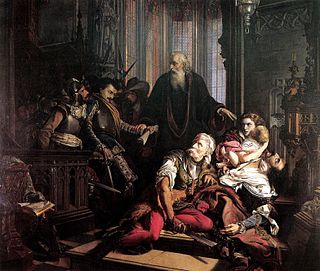
Kuruc, also spelled kurutz, refers to a group of armed anti-Habsburg insurgents in the Kingdom of Hungary between 1671 and 1711.

The Battle of Zenta, also known as the Battle of Senta, was fought on 11 September 1697, near Zenta, Kingdom of Hungary, between Ottoman and Holy League armies during the Great Turkish War. The battle was the most decisive engagement of the war, and it saw the Ottomans suffer an overwhelming defeat by an Imperial force half as large sent by Leopold I, Holy Roman Emperor.

The Second Battle of Mohács, also known as the Battle of Harsány Mountain, was fought on 12 August 1687 between the forces of Ottoman Sultan Mehmed IV, commanded by the Grand Vizier Sarı Süleyman Pasha, and the forces of Leopold I, Holy Roman Emperor, commanded by Charles of Lorraine. The result was a decisive victory for the Austrians.

The Battle of Saint Gotthard, of the Austro-Turkish War (1663–1664), took place on 1 August 1664 on the Raab between Mogersdorf and the Cistercian monastery St. Gotthard in West Hungary. It was fought between Imperial Army forces, including German, Swedish and French contingents, led by Imperial commander-in-chief Count Raimondo Montecuccoli and the army of the Ottoman Empire under the command of Köprülü Fazıl Ahmed Paşa.
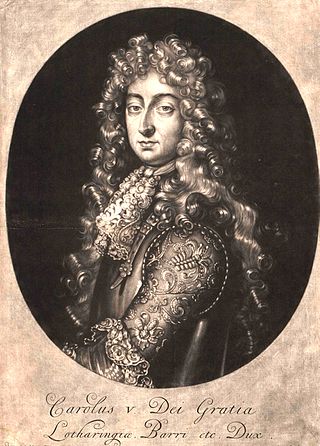
Charles V, Duke of Lorraine and Bar succeeded his uncle Charles IV, Duke of Lorraine as titular Duke of Lorraine and Bar in 1675; both duchies were occupied by France from 1634 to 1661 and 1670 to 1697.
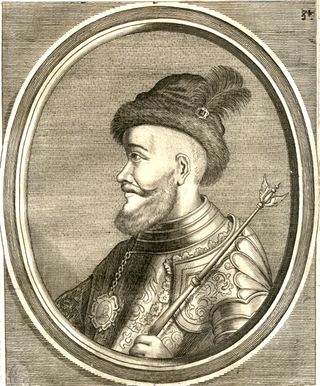
Michael Apafi was Prince of Transylvania from 1661 to his death.

The Battle of Párkány was fought between October 7–9, 1683 in the town of Párkány, in the Ottoman Empire, and the area surrounding it as part of the Polish-Ottoman War and the Great Turkish War. The battle was fought in two stages. In the first stage Polish troops under John III Sobieski were defeated by the Ottoman army under Kara Mehmed Pasha on October 7, 1683. In the second stage Sobieski, supported by Austrian forces under Charles V, Duke of Lorraine, defeated the Ottoman forces, which were supported by the troops of Imre Thököly, and gained control of Párkány on October 9, 1683. After the Ottoman defeat, the Austrians would besiege Esztergom and captured it at the end of 1683.
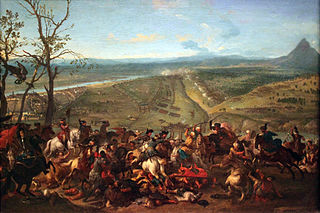
The siege of Belgrade was a successful attempt by Austrian troops under the command of Prince Eugene of Savoy to capture the strategically important city of Belgrade from the Ottoman Empire. It took place during the Austro-Turkish War (1716–1718), barely a year after the Austrian victory at the Battle of Petrovaradin (Peterwardein). The Imperial Army routed the Ottoman relief army under Grand Vizier Hacı Halil Pasha on 16 August. As a consequence, the Belgrade garrison, deprived of relief, surrendered to the Austrians on 21 August. The Ottoman Sultan Ahmed III sued for peace, resulting in the Treaty of Passarowitz a year later, which completed the transfer of the remainder of Hungary, the Banat and the city of Belgrade into Austrian hands.
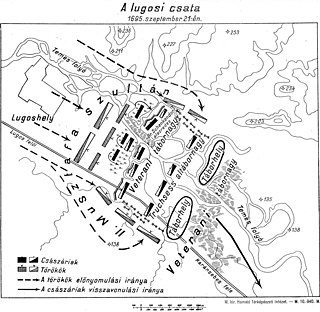
The Battle of Lugos was fought on 21 September 1695 near the city of Lugos in the East Banat, between the forces of the Ottoman Empire and the forces of the Habsburg monarchy as part of the Great Turkish War.
The Battle of Zernest was fought on 11 August 1690, near the town of Zernest in southeastern Transylvania, between the allied forces of Transylvania and the Holy Roman Empire, and the allied forces of the Ottoman Empire, Tatar allies, Wallachians, and Hungarian Kurucs.

Antonio von Caraffa was a General Commissary (Generalkriegskommissär) of the Imperial-Habsburg Army—the highest rank in the Austrian military hierarchy at the time. He also held various other high-ranking offices, including military governor of Upper Hungary and later royal commissioner of Transylvania.
Arabacı Ali Pasha was a short-term Albanian Ottoman grand vizier from 1691 to 1692. His epithet arabacı means "charioteer" in Turkish, an allusion to his practice of sending his political enemies to death or exile in a certain tumbrel.

The Battle of Olasch took place after a Habsburg Imperial army led by Saxon Elector General, Augustus II the Strong, laid siege to Turkish held Temesvár. On 26 August 1696, after learning that Sultan Mustafa II's relief army was crossing the Danube at Pancsova, Augustus gave up the siege and headed to meet the Ottoman army. The battle near the Bega River resulted in a draw after both armies retreated with heavy casualties on both sides. Strategically, the Ottoman army's campaign can be considered a success, as it achieved its goal of retaining Temesvár.






















